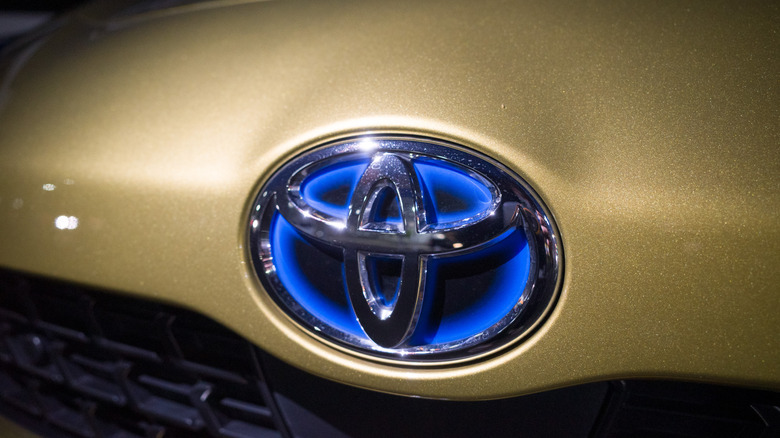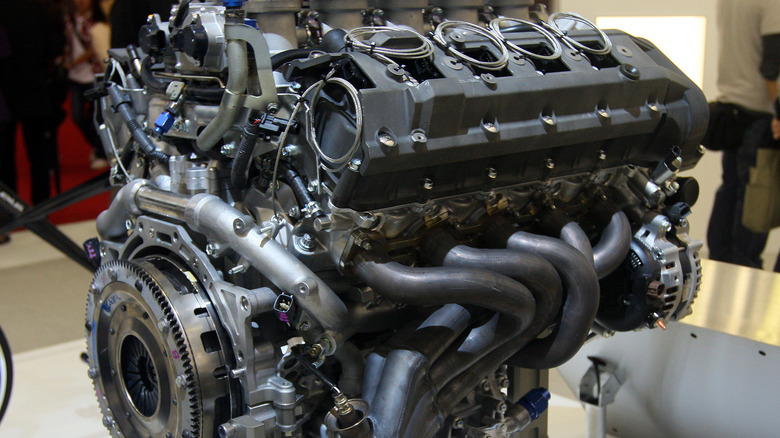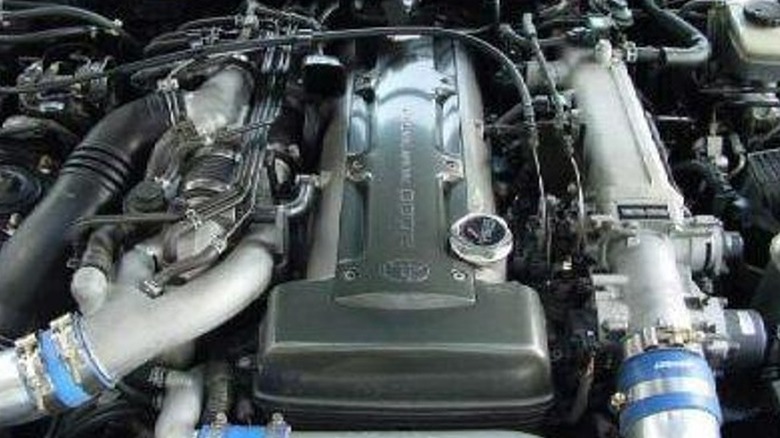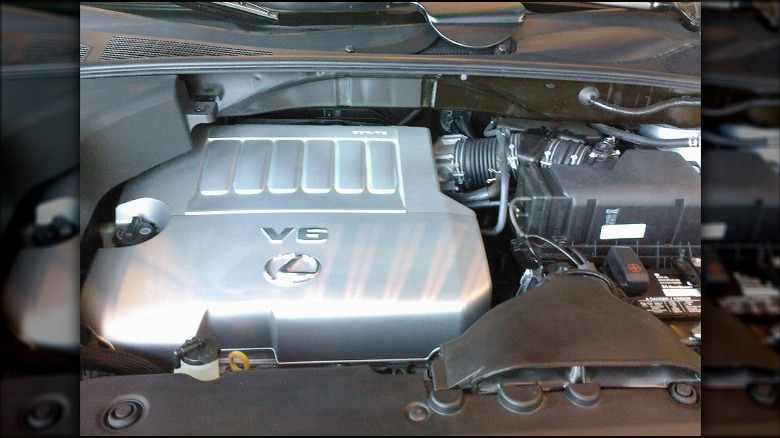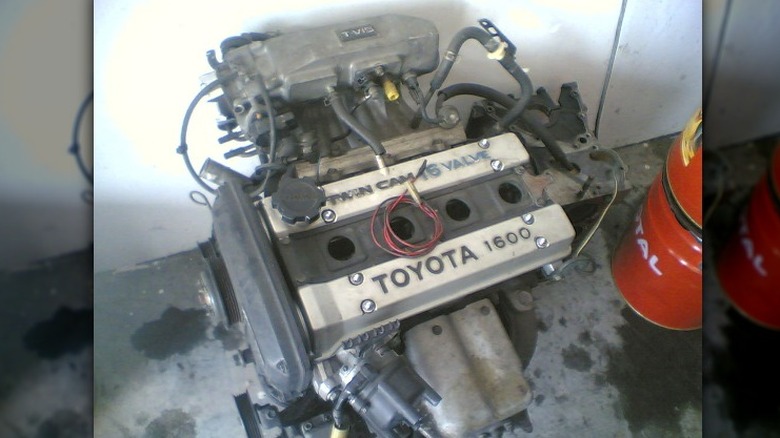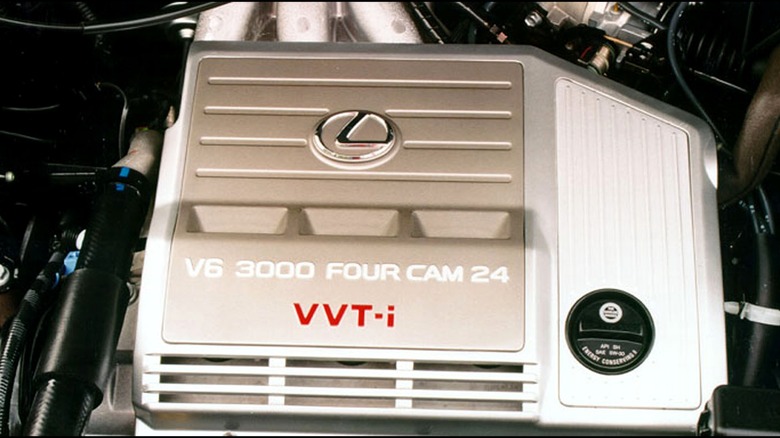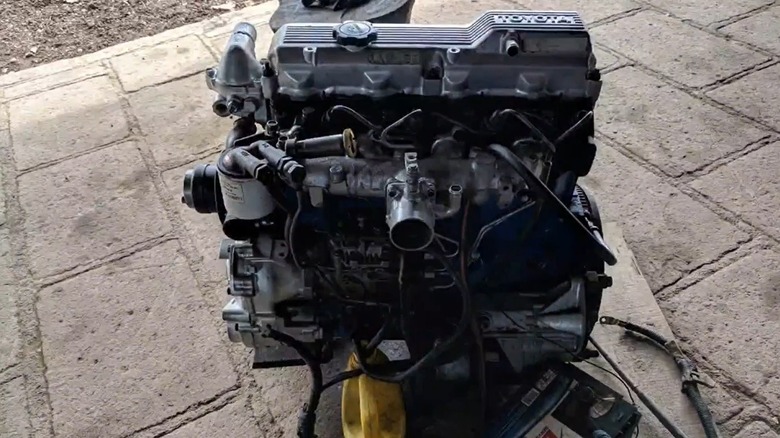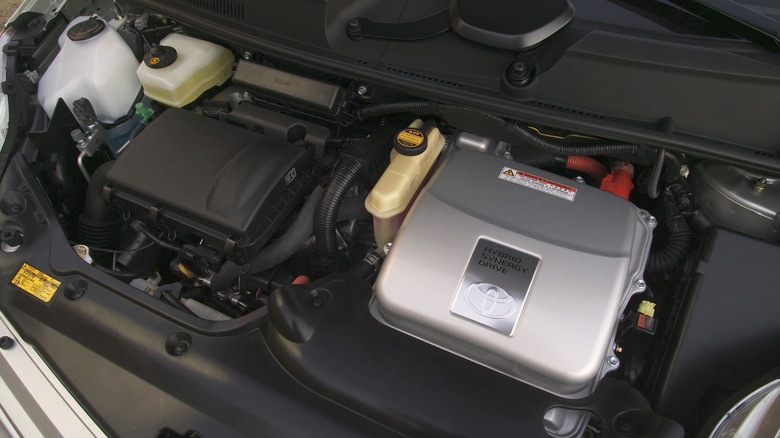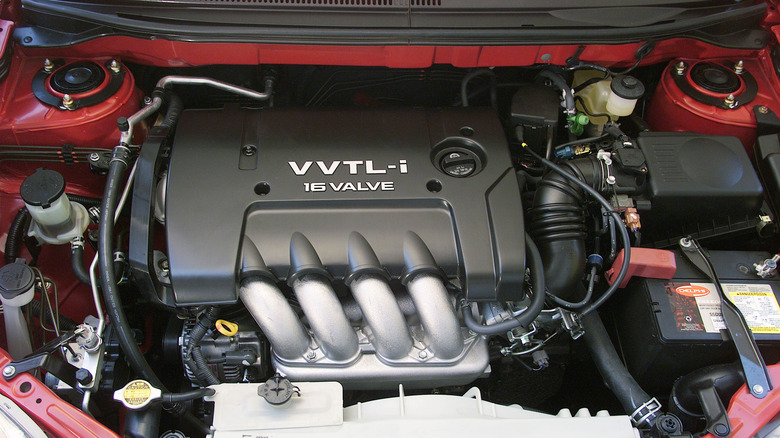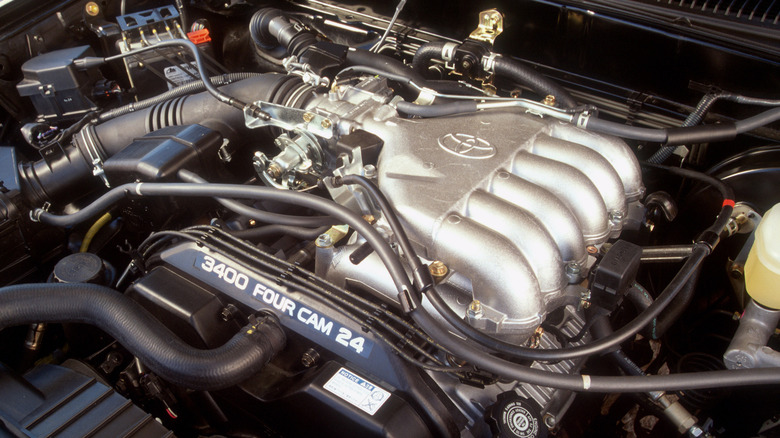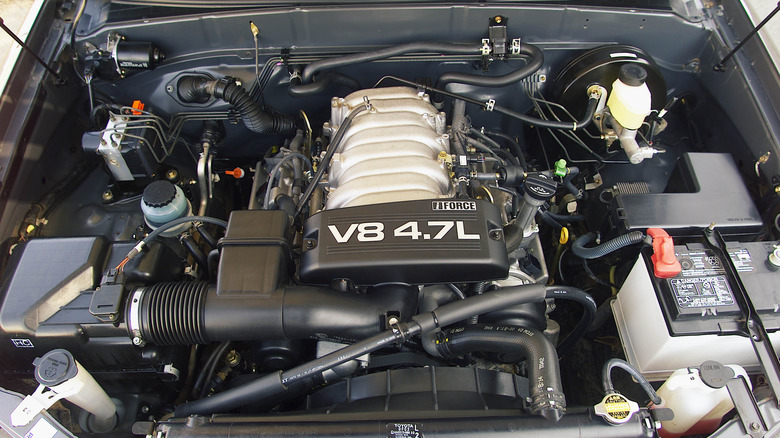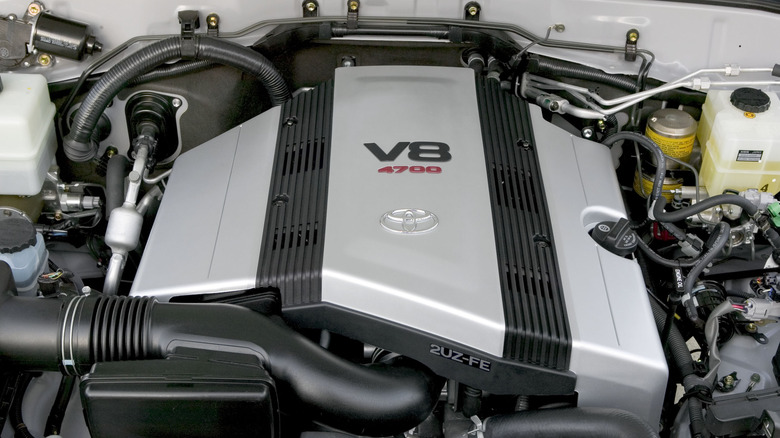10 Of The Most Reliable Toyota Engines Ever Built, Ranked
Toyota has long been an industry standard bearer in the automotive performance world. Toyota represents one of the best-selling brands in the United States, with a roughly 15% market share overall and more than 2 million vehicles sold in the U.S. in 2022.
Between its electric vehicle offerings and ICE heritage models that date back decades, Toyota has routinely been in a leadership role in building and selling quality cars. Toyota isn't just a commuter or truck brand, though — the company produces some of the most reliable models on the road today.
This starts with the engines that power both modern and vintage Toyota examples. The cars produced under the Toyota badge (and those owned by Toyota Group) are propelled by some of the most technologically advanced and ruggedly reliable motors that have ever left an automotive factory floor. These are the most reliable examples of Toyota engines that have ever gone under the hood.
10. 1LR-GUE V10
Starting off the list is the 1LR-GUE. This is a V10 model that was produced specifically for a single, limited-run production model, the Lexus LFA (debuting in 2009). The V10 is a work of art and was hand-built. Its uniqueness isn't found in the typical production engine -– especially from one of the world's largest brands.
The engine was explicitly created to underpin the performance metrics of the Lexus LFA model that had emerged from the research and development team as the brand's flagship performance vehicle. To generate the allure Toyota sought in its Lexus supercar, the team partnered with Yamaha to develop a highly technical engine that showcased stunning performance metrics and sounded fabulous when a driver laid on the gas pedal.
The result was a 4.8L V10 that put out 552 horsepower and 354 lb-ft of torque. The engine was naturally aspirated and could push the car to a top speed of 202 miles per hour with a 0-60 time of just 3.7 seconds. What sets this V10 apart from the typical muscular engine is its engineering and construction. The production is built from lightweight materials and employs a compact design – including a 72-degree angle between the cylinder pairs. This makes it weigh in around the same as a V6 and occupy the space of a V8. The technology that went into the design of the 1LR-GUE engine made it a reliable and high-performance powerplant that is still discussed today.
9. 2JZ-GTE Inline Six
Toyota's 2JZ-GTE made its U.S. debut in the 1993 Supra Turbo. It offered substantial oomph with no immediate need for modification to coax ample horsepower out of the powerplant. For this engine, Toyota opted for an Inline Six design rather than a V6 infrastructure to keep the movement within the engine block to a minimum. The result was a potent power supply employed in a wide range of additional use cases. Moreover, the block is forged from a cast iron design, giving it substantial durability and the massive power output that can be pulled from within the engine. Even ChatGPT named this engine one of the best ever made when we asked, and if it takes a machine to know a machine, then perhaps that's a ringing endorsement.
Toyota built the engine model between 1991 and 2005. It offers drivers a 3.0L, twin-turbocharged Inline Six construction that's air-cooled. The engines built for export to the U.S. market came with alternative turbocharger installations and other modifications. The result was an engine that produced 320.5 horsepower and 325.5 ft-lb of peak torque. The second generation engines, built starting in 1997, utilized a new inlet camshaft design that improved the maximum torque rating to 332.8 ft-lb.
8. 2GR-FE V6
The 2GR-FE is a V6 engine built from aluminum for speed and lightweight agility. This is one of Toyota's most common engines in the modern marketplace, making it immensely durable and easy to service in the event of an issue. The 2GR-FE is very similar to the 1GR model, but it has the unique distinction of being noted as a winner of the Ward's 10 Best Engines award for four straight years.
Toyota's 2GR-FE engine weighs 395 pounds, producing between 295 and 315 horsepower and 248 to 260 ft-lb of torque. The engine is a 3.5L V6 built with an open deck design. In later engine models, the powerplant includes direct fuel injection that amplifies the power output for those seeking a subtle tweak to the performance standards of their car. What's more, owners of a Toyota loaded with the 2GR-FE engine will often find enhancements and upgrades to the stock format easier with this engine than many other models on the marketplace, making it a reliable powerplant that's also infinitely customizable for just the right ride.
7. 4A-GE Inline Four
An Inline Four might seem pedestrian on a list of fantastic and virtually unstoppable engine builds. Still, Toyota's 4A-GE engine was a technological leap forward when it was introduced and continues to be a favorite in aftermarket enhancements of vintage and contemporary Toyota models. This makes the 4A-GE a reliable and potent engine option for Toyota enthusiasts decades after it first hit the market. The engine was one of the first fuel-injected four-cylinder options to utilize a 16-valve infrastructure and twin-cam design.
The engine was built in Toyota factories for nearly 20 years (from 1983 to 2002) and was installed in a wide range of Toyota models during its production run. The 16-valve build could produce between 110 and 140 horsepower, while a larger 20-value unit boosted this output to a range between 160 and 165 horsepower. Depending on the valve option, the cast iron block created between 130 and 150 Nm and 160 to 165 Nm of torque. Moreover, the engine had an estimated lifespan rating of nearly 190,000 miles, making it a workhorse under the hood of any vehicle that carried it.
6. MZ-series
The Toyota MZ saw life with the Toyota Avalon, Toyota Camry, and the first generation Lexus RX of the late 1990s into the early 2000s. Every car it was featured in was as ubiquitous as it was reliable. The 3-liter V6 served as an optional slightly spicier powerplant for the Camry and the standard engine in the Lexus and Avalon. In the Lexus RX 300, it made 220 horsepower and 222 pound feet of torque. It was by no means a powerhouse of performance like Toyota's other well-renowned six-cylinder, the 2JZ, but that doesn't mean it shouldn't have its own share of fame.
Toyota forums from all over the internet attest that the MZs are reliable and generally fairly steady as long as you keep up with maintenance. The engines are known to occasionally leak oil, but that's not too much of an issue if you regularly change fluids. The 1996 Camry I owned that featured a 1MZ-FE engine leaked oil very slowly to an almost negligible amount. It reached 165,000 miles before any problems, namely a tree fell on it, but that's hardly an indictment of the engine.
5. 3B Diesel
Without a doubt, the most reliable engine ever produced by Toyota has to be the 3B Diesel. These aren't powerhouse speed demons. However, the 3B (and other B Series engines built by Toyota and its subsidiaries) pushed out significant torque ratings at low RPMs. They have often been known to run for hundreds of thousands of miles before giving out and requiring replacement. These engines were found in the Land Cruiser 60 Series and have made their way into a wealth of other automotive and heavy utility uses.
The 3B engine produces 98 brake horsepower and a peak torque of 166.3 lb-ft at a super-low figure of 2200 RPMs. The engine won't likely win you many races, but the 3.4L, 4-cylinder OHV engine will run for as long as needed. This engine is the perfect complement to a vehicle that doesn't seek to create a flashy entrance or rush along the open road at top speed. Instead, this is the ideal powerplant to underpin a sturdy vehicle that will last its owner a lifetime if necessary.
4. NZ-series
The Toyota Prius is fairly widely known as an incredibly reliable vehicle. The entire Prius line was built to do exactly two things: achieve excellent fuel economy, and accomplish that task reliably. It succeeds at both of those things. Although the Prius engine is only a part of the equation, given its hybrid drivetrain, the NZ-series engines that powered the Prius and its derivatives for the first and second generations, as well as the compact Prius c (known as the Aqua overseas).
The engine itself, designated the 1NZ-FXE, is a 1.5-liter four cylinder that makes a thundering 110 horsepower when the hybrid drivetrain is working its magic. It's just enough to cruise on the highway and do exactly nothing more strenuous than that. 46 combined miles per gallon helps matters quite a bit. There are numerous reports online from enthusiast forums (yes, Prius enthusiasts do exist) and automotive web pages waxing poetic over the Prius reliability. I owned a 2005 Prius that hit 190,000 miles before the battery started to fail. Even then, the engine never quit.
3. ZZ-Series
If there's one thing you should learn about Toyota, it's that the brand won't complicate things when it can avoid it. That's why you'll see one engine distributed over several product lines for both Toyota, Lexus, and whoever else wants a piece of the power plant pie. No other engine exemplifies that ideal better than the Toyota ZZ engine. The list of cars graced with the ZZ is dozens of entires long, but most know it from the mid-1990s to the early 2000s. It saw service in eternal longevity all stars like the Corolla, but it also graced the engine bay of some oddballs like the Pontiac Vibe and the Lotus Elise.
In applications like the Corolla, the venerable 1.8-liter four-banger made 125 horsepower and the same number in pound-feet for torque. You probably aren't going to set any land speed records with a ZZ, but you can be reasonably sure that it will get you where you need to go without much fuss for many years on end. Corolla's, especially from the early 2000s are legendarily reliable, if not that exciting to drive. Everyone from enthusiasts on forums to Redditors all over the world have sung the praises of the nearly indestructible Corolla from the era and the ZZ powerplant is a major part of the adulation.
2. VZ-series
The Toyota VZ engines were featured in the engine bay of the V6 versions all manner of mid-size and compact trucks, cars, and SUVs like the Tacoma and 4Runner of the 1990s. Anyone with an even passing knowledge of cars knows that an average Tacoma is incredibly dependable. The 3.4-liter variation of the storied V6, named the 5VZ, put out 190 horsepower and 220 pound feet of torque in the Tacoma, which were fairly stout numbers for the late 1990s.
As the engine is approaching 30 years old, the best place to ascertain its reliability is to look at Toyota owner's forums. The engine is highly praised in nearly all of its applications with stories of Tacomas and 4Runners eclipsing 300,000 miles with little more than regular maintenance and care. You really can't go wrong with any Toyota truck of any vintage if you are expecting reliability, but the 3.4-liter 5VZ stands out as one of Toyota's best in a sea of other great engines.
1. UZ-series
One engine, perhaps, stands above all other Toyotas (and maybe all other automotive engines in general) and that's the UZ-series. It was a 4.7-liter cast-iron UZ V8 that saw life in not only the first generation of Toyota Tundra trucks (I owned one with 260,000 miles on the clock), but also variations of the Land Cruiser. Smaller displacement UZ with aluminum blocks saw life in the first generation Lexus LS sedans. As it turns out, a robustly engineered, small displacement V8 that doesn't exert itself too hard with high RPMs and a lot of horsepower, makes for a reliable engine. Ford figured this out with the Modular V8 found in the Crown Victoria.
In the 1st-generation Lexus LS400, it wasn't outside the realm of possibility to hit over one million miles without very much in the way of overhaul. it wasn't just a Lexus that ferried the UZ-series to over a million miles. A 2007 Tundra with a 4.7-liter UZ hit seven digits on the odometer and a later teardown of the engine revealed that it showed very little signs of wear. The laws of thermodynamics and overall entropy still apply to even the most reliable car engines, but Toyota seems to have figured out how to slow down time.
The methodology
Toyota's lineup over the decades and its subsequent engines are all generally fairly reliable, and there really isn't a bad option among the wide array of engines that the brand offers. That being said, a few engines stand out as particularly robust or resilient above the rest of the crowd. With its use in the Tundra trucks and Lexus LS, the UZ-series stands out head and shoulders above the rest, as there are several stories of the engine reaching over one million miles. The VZ, ZZ, and NZ-series engines make the list purely out of ubiquity. The engines were made for decades and saw use in nearly every aspect of Toyota's lineup, giving the brand its excellent reputation.
Toyota's 3B, MZ-series, 4A-GE, and 2GR-FE arrive in the ranking as the powerplants are a little more obscure than an average Corolla engine, but are no less incredibly solid. Lastly, the two high-strung performance engines on the list, the 2JZ-GTE and 1LR-GUE, rank towards the bottom, not because either engine is a dud but quite the opposite. Both rank last because the cars the engines lived in, the Toyota Supra and Lexus LFA, respectively, are decidedly not daily drivers. The Supra, especially the twin-turbo variant, is well known as a race-ready horsepower monster, and Lexus only made 500 LFAs total, making it an extraordinarily rare car.
